

Scaled Agile Framework – SAFe for Lean Enterprises. Prioritizing “Non-Feature” Work and Continuous Improvement. Formation et Certification Agilité à l'échelle - Xebia Training. Story – Scaled Agile Framework. Stories act as a “pidgin language,” where both sides (users and developers) can agree enough to work together effectively.
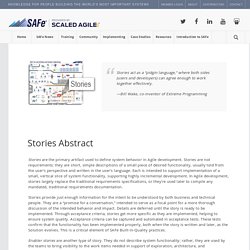
—Bill Wake, co-inventor of Extreme Programming Stories are the primary artifact used to define system behavior in Agile development. Stories are not requirements; they are short, simple descriptions of a small piece of desired functionality, usually told from the user’s perspective and written in the user’s language. Each is intended to support implementation of a small, vertical slice of system functionality, supporting highly incremental development.
In Agile development, stories largely replace the traditional requirements specifications, or they’re used later to compile any mandated, traditional requirements documentation. Stories provide just enough information for the intent to be understood by both business and technical people. Enabler stories are another type of story. Initially, stories are typically written on an index card or sticky note. ScrumXP – Scaled Agile Framework. . . . a holistic or “rugby” approach—where a team tries to go the distance as a unit, passing the ball back and forth—may better serve today’s competitive requirements.
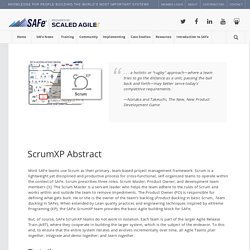
—Nonaka and Takeuchi, The New, New Product Development Game Most SAFe teams use Scrum as their primary, team-based project management framework. Scrum is a lightweight yet disciplined and productive process for cross-functional, self-organized teams to operate within the context of SAFe. Scrum prescribes three roles: Scrum Master, Product Owner, and development team members [3]. Program Increment – Scaled Agile Framework. Many people don’t focus enough on execution.
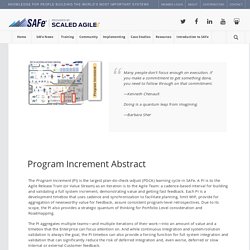
If you make a commitment to get something done, you need to follow through on that commitment. —Kenneth ChenaultDoing is a quantum leap from imagining. —Barbara Sher The Program Increment (PI) is the largest plan-do-check-adjust (PDCA) learning cycle in SAFe. A PI is to the Agile Release Train (or Value Stream) as an Iteration is to the Agile Team: a cadence-based interval for building and validating a full system increment, demonstrating value and getting fast feedback. Program and Value Stream Backlogs – Scaled Agile Framework. The emphasis should be on why we do a job.

—W. Edwards Deming. Team Kanban – Scaled Agile Framework. The only way you can create excess inventory is by having excess manpower.
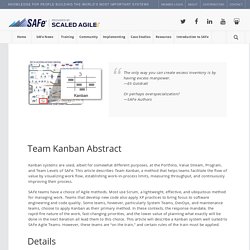
—Eli GoldrattOr perhaps overspecialization? Guidance – Refactoring – Scaled Agile Framework. You just have to have the guidance to lead you in the direction until you can do it yourself.
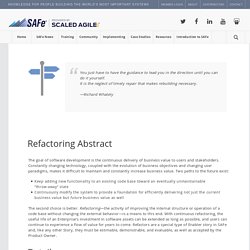
It is the neglect of timely repair that makes rebuilding necessary. —Richard Whately The goal of software development is the continuous delivery of business value to users and stakeholders. Constantly changing technology, coupled with the evolution of business objectives and changing user paradigms, makes it difficult to maintain and constantly increase business value. Guidance – Scaled Agile Framework. You just have to have the guidance to lead you in the direction until you can do it yourself.— Tina Yothers A Lean Perspective on SAFe Portfolio WIP Limits Although SAFe provides high-level guidance on WIP limits at the portfolio level, there are important nuances that are key to understanding how the portfolio level in SAFe is work in process (WIP) limited.
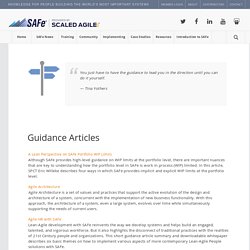
In this article, SPCT Eric Willeke describes four ways in which SAFe provides implicit and explicit WIP limits at the portfolio level. Agile ArchitectureAgile Architecture is a set of values and practices that support the active evolution of the design and architecture of a system, concurrent with the implementation of new business functionality. With this approach, the architecture of a system, even a large system, evolves over time while simultaneously supporting the needs of current users. Domain Modeling Domain modeling is a way to describe and model real-world entities and the relationships between them. Guidance – Spikes – Scaled Agile Framework. If we knew what we were doing, it wouldn’t be called research.
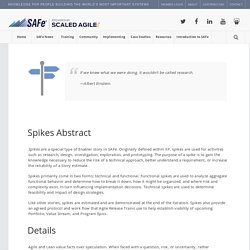
—Albert Einstein Spikes are a special type of Enabler story in SAFe. Originally defined within XP, spikes are used for activities such as research, design, investigation, exploration, and prototyping. Agile Teams – Scaled Agile Framework. Nothing beats an Agile Team.
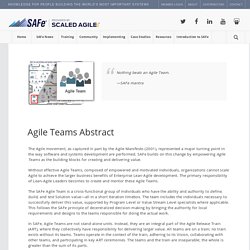
—SAFe mantra The Agile movement, as captured in part by the Agile Manifesto (2001), represented a major turning point in the way software and systems development are performed. Agile Release Train – Scaled Agile Framework. Principle of Alignment: There is more value created with overall alignment than local excellence.

Value Stream Coordination – Scaled Agile Framework. Two captains sink the ship.– Turkish Proverb Value Streams are the most fundamental construct in SAFe. They provide a focus that helps the Lean-Agile Enterprise better understand the flow of value, from concept to delivery. As an enterprise better understands the various flows, they can focus their attention on organizing around them and further optimizing them by reducing waste, unnecessary steps, and delays. In this way the sustainably shortest lead time can be achieved and continuously reduced.
Therefore, it is sensible that value streams are organized to be largely independent. A Process and Simple Tool for Planning Portfolio Work – Scaled Agile Framework. By Alex Yakyma Introduction Given the criticality of the Agile Release Train to value delivery in SAFe, SAFe has always provided fairly extensive guidance on PI Planning. With 4.0, we introduced planning for larger Value Streams that require multiple Agile Release Trains to build the Solution. Iteration Planning – Scaled Agile Framework. Stay committed to your decisions, but stay flexible in your approach. —Tom Robbins Team-based Iteration Planning is one of the key mechanisms for decentralizing control and empowering fast, local decision-making. In Scrum, teams plan by selecting Stories from the product backlog and committing a set of them for execution in the upcoming Iteration. This basic process is fundamental to SAFe as well, but the context is broader, as SAFe teams are part of an Agile Release Train (ART).
As such, the team’s backlog has already been seeded and partially preplanned during the PI Planning meeting. Iteration Execution – Scaled Agile Framework. Vision without execution is hallucination. Team Demo – Scaled Agile Framework. Working software is the primary measure of progress. —Agile ManifestoSeeing is believing. —Anonymous Until people can see and touch the results of a Story or a Feature, it’s just an abstract concept, so the demonstration of working, tested systems to Customers (or their proxies) is a concrete, seminal moment. To this end, depending on the scope of the Solution, there are three demos prescribed in SAFe: the Solution Demo, the System Demo, and the Team Demo. Iteration Retrospective – Scaled Agile Framework. At regular intervals, the team reflects on how to become more effective, then tunes and adjusts its behavior accordingly.